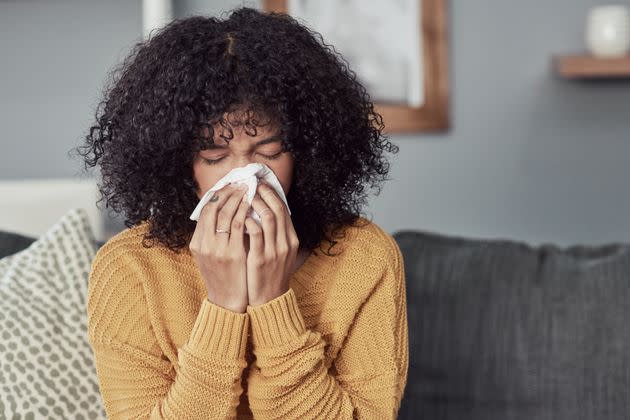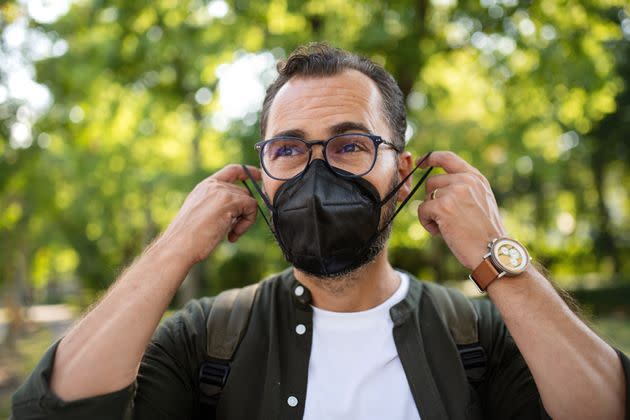The Most Common COVID Symptoms Doctors Are Seeing This Spring

As we head into summer, there’s a new dominant COVID-19 variant that’s infecting people across the United States. KP.2 now represents 28% of COVID-19 infections in the country, according to the Centers for Disease Control and Prevention.
“KP.2 is one of several variants being referred to as ‘FLiRT variants,’ named after the technical names for their mutations,” Dr. Purvi Parikh, an immunologist at NYU Langone Health, told HuffPost via email. KP.2 is a descendent of the JN.1 strain from the winter, Parikh added.
Specifically, the FLiRT variants have a similar mutation in the spike protein, said Dr. Donald Dumford, an infectious disease physician at Cleveland Clinic Akron General in Ohio. “That spike protein is what the virus uses to actually attach to and penetrate our lung cells.”
“It has new mutations which may evade antibodies (this is normally how viruses evolve and survive),” Parikh explained.
Currently, COVID-19 cases are low, according to the American Medical Association, but it’s worth knowing the signs of spring COVID infections and how best to protect yourself from getting infected with KP.2 or another FLiRT variant. Below, experts share the common COVID-19 symptoms they’re seeing this spring and their tips to stay healthy:
Like other COVID-19 variants, the symptoms consist of cough, sore throat, fever and fatigue.
“The symptoms are really no different than what we’re seeing with other COVID variants at this point,” Dumford said.
Most people who get infected will generally feel unwell and have symptoms such as a sore throat, fever and cough, Parikh said. A runny nose is also common, noted Dumford, as is fatigue, headache and muscle aches, according to the CDC. If you have symptoms such as trouble breathing, confusion and a fever above 103 degrees, you should see a doctor immediately.
“Right now, what we’re seeing is most people are having relatively mild illness, and that’s just because almost all of us — it’s reported as over 95% of us — have some amount of immunity to COVID viruses at this point,” said Dumford, either from prior infections or vaccinations.
This means that even if you do become exposed to a new COVID-19 variant, you have some background immunity that can quell your symptoms if not stopping the infection altogether, he said.
The risks of long COVID and severe infection are still real for many people.
Just because COVID infections tend to be more mild now doesn’t mean you should discount the virus. “Even these less severe illnesses can last weeks and make one feel miserable, not to mention there’s a risk of long [COVID],” said Parikh.
Long COVID can lead to health issues including heart palpitations, shortness of breath, brain fog and joint pain. Certain groups of people are at higher risk of hospitalization or death due to a COVID infection, too.
“I think we do have to highlight that we still do see the severe cases of COVID occasionally in the hospital,” Dumford said, noting that it’s usually people in vulnerable populations. “Those over the age of 60, those with other respiratory conditions like emphysema and COPD, people with immune system problems, pregnant patients .... I think even though we’re seeing mild cases, we still have to remember there’s people out there that can get really sick from it.”

Make sure you’re up to date on your vaccinations and follow healthful protocols if you’re sick.
“I’m always a proponent of vaccines ... the most recent vaccine recommendations is that those over the age of 65 should have gotten an additional booster this spring,” said Dumford. “If they haven’t, there’s still an opportunity to do that.” There is expected to be a new COVID vaccine that targets the circulating strains in the fall, which you should also get.
Parikh added that hand-washing and masking can help bolster your protection from getting sick, too.
COVID “is now an endemic virus [that’s] here to stay, and we must continue to take simple steps to protect ourselves and others and reduce transmission, especially to avoid long-term effects like long [COVID],” Parikh said.
If you do get sick, be sure to follow the isolation guidelines.
“Essentially now they’re doing COVID isolation similar to all respiratory viruses ... so, if you have symptoms [or] you have a fever, you should stay home until [the symptoms] are improving and also that you’re fever-free for 24 hours without fever reducing medication,” Dumford said.
Once you end isolation, you should wear a tight-fitting mask for five days to keep from getting those around you sick, he noted.
Compared with the infection spikes earlier in the pandemic, COVID-19 cases now are (thankfully) way down, but it doesn’t mean you can throw caution to the wind. “I just want to make sure people know it’s still circulating, and you have to think about it and take take appropriate precautions,” Dumford said.

